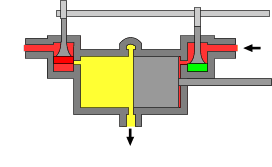Direct current steam engine
The direct current steam engine is a special type of steam engine . It is characterized by the fact that the fresh steam is let in separately from the exhaust steam. It is advantageous here that the areas of the steam cylinder where the live steam is let in are not cooled by the exhaust steam. This prevents premature partial condensation of the live steam.
The direct current steam engine found widespread use by locomotives , i. H. mobile combinations of steam boilers and mounted steam engines. These were mainly used in agriculture in the East Elbe .
In shipbuilding , these steam engines (especially the Stumpf type in Germany ) held their own . However, tests with locomotives, such as the Prussian S 10, showed no clear advantages. With the spread of the use of superheated steam, there were no more advantages to using direct-current cylinders.
